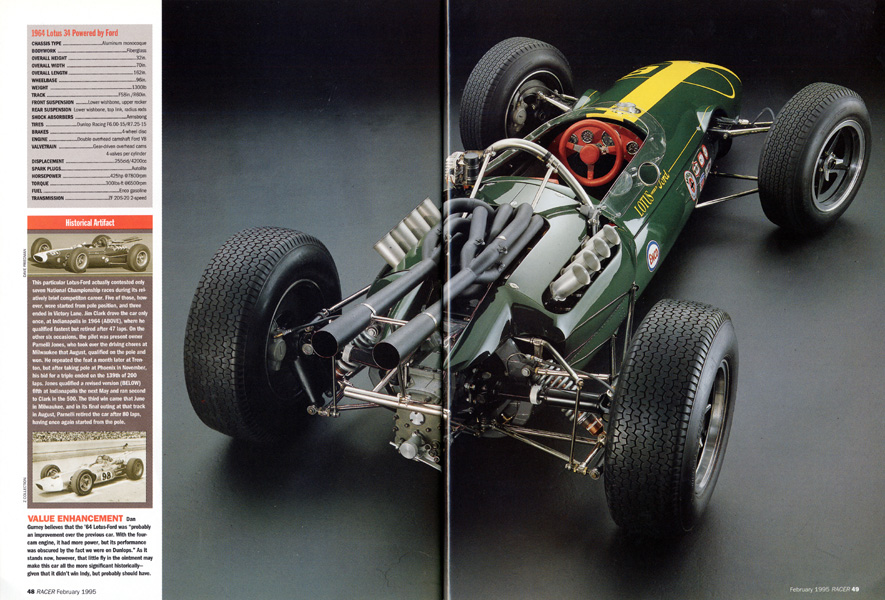
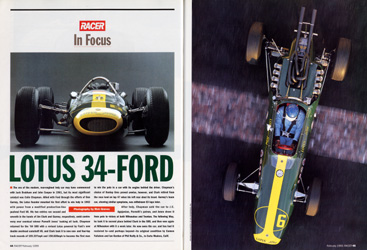
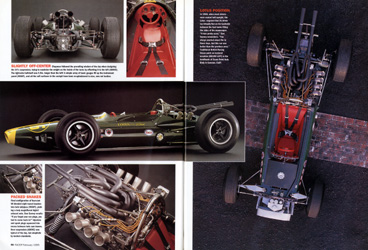
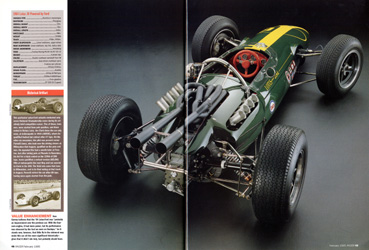
In Focus
Lotus 34-Ford
The era of the modern, rear-engined Indy car may have commenced with Jack Brabham and John Cooper in 1962, but its most significant catalyst was Colin Chapman. Allied with Ford through the efforts of Dan Gurney, the Lotus founder mounted his first effort to win Indy in 1963 with power from a modified production-line pushrod Ford V8. His two entries ran second and seventh in the hands of Jim Clark and Gurney, respectively, amid controversy over eventual winner Parnelli Jones' leaking oil tank. Chapman returned for the '64 500 with a revised Lotus powered by Ford's new double overhead camshaft V8, and Clark took it to new one- and four-lap track records of 159.337 mph and 158.828 mph to become the first man to win the pole in a car with its engine behind the driver. Chapman's choice of Dunlop tires proved unwise, however, and Clark retired from the race lead on lap 47 when his left rear shed its tread. Gurney's team car, showing similar symptoms, was withdrawn 63 laps later.
After Indy, Chapman sold the car to J.C. Agajanian, Parnelli's patron, and Jones drove it from pole to victory at both Milwaukee and Trenton. The following May, he took it to second place behind Clark in the 500, and then won again at Milwaukee with it a week later. He now owns the car, and has had it restored to--and perhaps beyond--its original condition by Eamon Fullalove and Ian Gordon of Phil Reilly & Co., in Corte Madera, Calif.
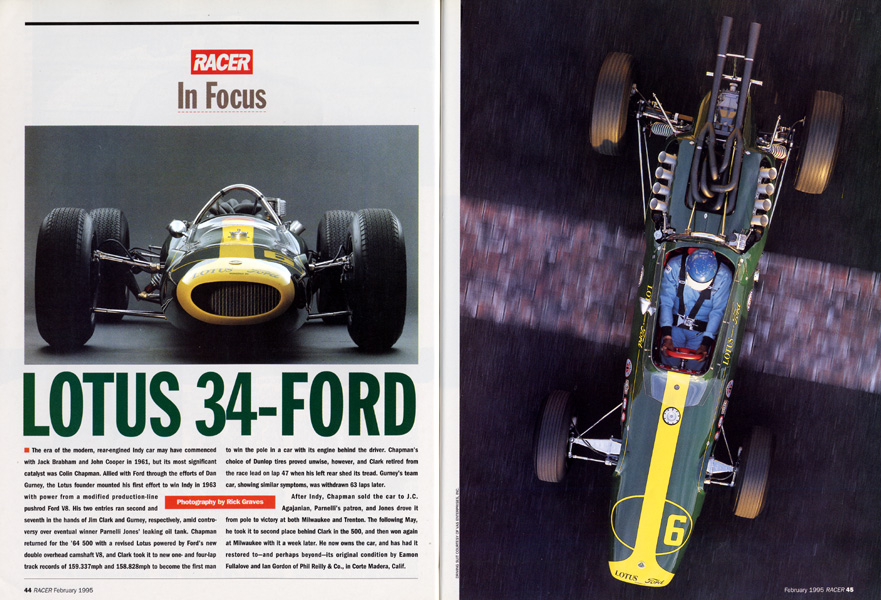 |
Slightly Off-Center
Chapman followed the prevailing wisdom of the day when designing the 34's suspension, trying to maximize the weight on the inside of the turns by offsetting it to the left (ABOVE). The right-side halfshaft was 5.5 in. longer than the left! A smile array of basic gauges fill up the instrument panel (RIGHT), and all the soft surfaces in the cockpit have been re-upholstered in nice, new red leather.
Packed Snakes
Final configuration of four-cam V8 blended eight tuned headers into twin tailpipes (RIGHT), yielding a truly magnificent high-C exhaust note. Dan Gurney recalls: "If you forgot your ear plugs, you had to come back in!" Injectors and spark plugs squeezed into recess between twin cam towers. Rear suspension (ABOVE) was typical of the day, but simplistic by modern standards.
Lotus Position
In 1964, when most drivers were seated bolt upright, the Lotus required that its driver lay virtually flat on his backside between the fuel tanks filling the sides of the monocoque. "It was pretty scary," Dan Gurney remembers. "You always worried about fire in those days, but this car was better than the previous ones." Traditional British Racing Green paint on restored machine (BELOW LEFT) is the handiwork of Sears Point Auto Body in Sonoma, Calif.
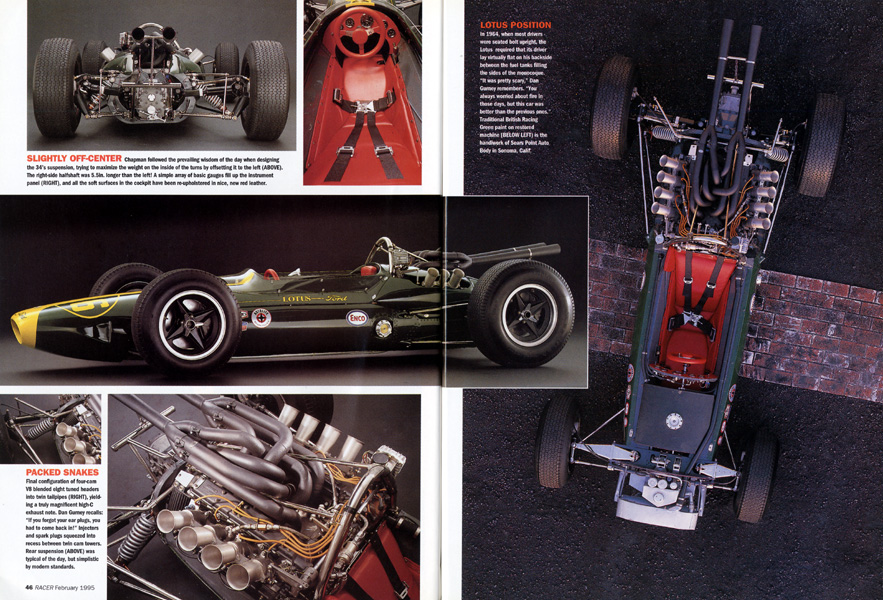
1964 Lotus 34 Powered by Ford
Chassis Type - Aluminum monocoque
Bodywork - Fiberglass
Overall Height - 32 in.
Overall Width - 70 in.
Overall Length - 162 in.
Wheelbase - 96 in.
Weight - 1300lb.
Track - F58in./R60in.
Front Suspension - Lower wishbone, upper rocker
Rear Suspension - Lower wishbone, top link, radius rods
Shock Absorbers - Armstrong
Tires - Dunlop Racing F6.00-15/R7.25-15
Brakes - 4-wheel disc
Engine - Double overhead camshaft Ford V8
Valvetrain - Gear-driven overhead cams 4-valves per cylinder
Displacement - 255cid/4200cc
Spark Plugs - Autolite
Horsepower - 425hp @ 7800rpm
Torque - 300lbs-ft @ 6500rpm
Fuel - Enco gasoline
Transmission - ZF 2DS-20 2-speed
Historical Artifact
This particular Lotus-Ford actually contested only seven National Championship races during its relatively brief competition career. Five of those, however, were started from pole position, and three ended in Victory Lane. Jim Clark drove the car only once, at Indianapolis in 1964 (ABOVE), where he qualified fastest but retired after 47 laps. On the other six occasions, the pilot was present owner Parnelli Jones, who took over the driving chores at Milwaukee that August, qualified on the pole and won. He repeated the feat a month later at Trenton, but after taking pole at Phoenix in November, his bid for a triple ended on the 139th of 200 laps. Jones qualified a revised version (BELOW) fifth at Indianapolis the next May and ran second to Clark in the 500. The third win came that June in Milwaukee, and in its final outing at that track in August, Parnelli retired the car after 80 laps, having once again started from the pole.
Value Enhancement
Dan Gurney believes that the '64 Lotus-Ford was "probably an improvement over the previous car. With the four-cam engine, it had more power, but its performance was obscured by the fact we were on Dunlops." As it stands now, however, that little fly in the ointment may make this car all the more significant historically -- given that it didn't win Indy, but probably should have.
